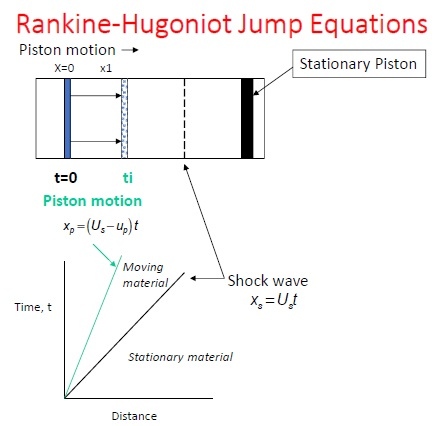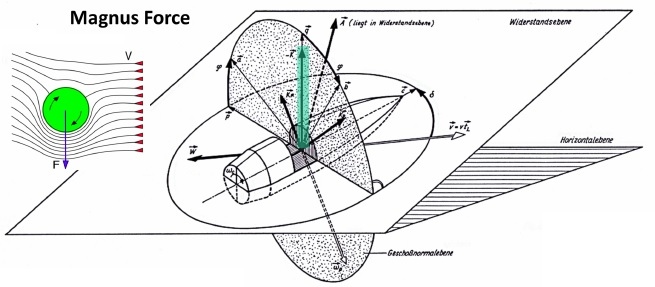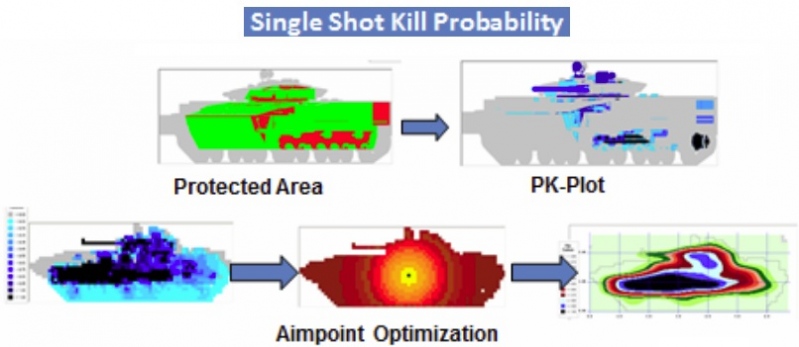Tutorials for 30th ISB

 DETONICS EXTERIOR BALLISTICS
DETONICS EXTERIOR BALLISTICS 
 SCIENCE OF ARMOR MATERIALS VULNERABILITY
SCIENCE OF ARMOR MATERIALS VULNERABILITY The program of short courses adjacent to the 30th International Symposium on Ballistics has been finalized and four different courses will be held:
- EB101 - Introductory Exterior Ballistics by Dr. Uwe Chalupka (Helmut-Schmidt-University, Hamburg, Germany)
- DE101 - Introduction on Detonics and Energetic Materials by Dr. Ronald E. Brown (University of Illinois, Urbana, IL, USA)
- TB101 - The Science of Armour Materials by Dr. Ian Crouch (Armour Solutions Pty Ltd, Trentham, Australia)
- VS101 - Introduction to Vulnerability and Survivability by Heinrich Dorsch (IABG Gmbh, Ottobrunn, Germany)
The courses provide an introduction to their areas of ballistics science and are aimed at managers, engineers, scientists, practitioners, students or experts from other fields. The planned duration of the courses is half a day so there are two parallel sessions on Monday morning, September 11, i.e., EB101 alongside VS101, and in the afternoon, i.e., DE101 alongside TB101. Each attendee will receive presentation slides and / or a handbook on the course material. The tutorials are not in conflict with the conference sessions because the first session happens on Tuesday morning.
The courses are briefly described below. If any other information is needed do not hesitate contacting the Education Committee Chair
Dr. Markus Graswald or ISB Co-Chairs.
Introductory Exterior Ballistics (see
example slides)
This course given by Dr. Uwe Chalupka aims at
- Providing an insight into the physics, modeling methods, and experimental techniques of non-powered projectiles in flight as well as rockets and missiles
- Enabling attendees to better follow and utilize papers presented at conference sessions and / or to qualify for participating in advanced courses
- Giving an overview of exterior ballistic standards within NATO
It is composed of the following contents:
- Introduction: course overview and scope, further reading / bibliography
- Exterior ballistics: vacuum ballistics, classical and modified point mass models, atmospheric models, Earth models, reference systems, forces and torques acting on the projectile, stability, numerical integration of equations of motion
- Exterior ballistics implementation within NATO: overview of relevant STANAGs and NATO Armaments Shareable Software Suite (S4)
Dr. Uwe Chalupka is employed as a Research Associate at the Chair of Measurement and Information Technology at the Helmut-Schmidt-University/University of the Federal Armed Forces Hamburg. From 2001 to 2006 he studied Media Engineering at the University of Applied Sciences in Leipzig and gained the doctoral degree in engineering at the Helmut-Schmidt-University/University of the Federal Armed Forces Hamburg in 2014 with the topic ‘A laser and computer based method for photogrammetric measurement of projectile trajectories’. Since 2006 he participated at the NATO Armaments Shareable (Fire Control) Software Suite programme in the field of software testing. In parallel he was working on various national projects within the context of exterior ballistics during the years. Uwe Chalupka has more than ten years of experiences in teaching, giving lectures and exercises in Computer Science, Ballistics, Measurement Engineering, Engineering Mechanics and Parallel Programming.
Detonics and Energetic Materials (see
example slides)
This course by Dr. Ronald E. Brown provides practical insights into the safety, security and application of explosive devices and specifically aims at
- Practical applications, e.g., technical evaluation, estimation, bases for inventiveness
- Shock and detonation physics, i.e., applicable conservation laws and derivations
- The explosive molecule, energetic materials, and expectations vs. usage potentials
Theoretically-based arguments will be presented for purposes of developing relationships and trends for the developer, engineer, experimenter and user:
- Potential applications of course topics ‘from initiation to detonation’ and ‘energy release and efficiencies’
- Shock and detonation physics (equations of states)
- The explosive molecule and energetic systems
- Estimation techniques, quantification of effects, and applications
Dr. Ronald E. Brown is an Adjunct Research Professor in the Mechanical Sciences and Engineering Department, University of Illinois, Urbana, IL. This post follows professorships at the Naval Postgraduate School, Monterey, CA and at the Helmut Schmidt University (of the German Armed Forces) in Hamburg, Germany. His professional career includes Director of Mine Countermeasures Research at BAE Systems and Vice President of Titan Corporation, during which he contributed to the development of several explosive products and improved products including shaped charge warheads for the several defense systems and patented charges for a wide-area mine clearer and humanitarian neutralization devices. Academic instruction and research include shock mechanics, explosive detonation, effects of reactive materials during hypervelocity impact, explosive ordnance neutralization, shaped charge jetting phenomenology, hydrodynamic flow stability, and finite difference techniques. Dr. Brown’s current interests are in the effects of supra-pressure initiation and detonation of explosives.
The Science of Armour Materials (see
example slides)
The objectives of the course given by Dr. Ian Crouch are as follows:
- To deliver the main message: the science of armour materials is not a codified branch of engineering but a science in its own right. A detailed and broad-ranging introduction will be given to armour materials and penetration mechanics, within the context of terminal ballistics, impact dynamics and armour physics
- To contextualize the role of numerical modelling and analytical techniques in the design of real armour systems for vehicles and personnel
- To ensure that attendees gain a better appreciation of the drivers behind armour design and the strong influence that material properties have upon ballistic performance and impact behaviour
The detailed contents of the course are:
- Traditional monolithic armours like steels and the light alloys, and armour systems like structural, appliqué and integrated. Designing simple and complex systems with precision engineering. The role of numerical modelling and analytical techniques in the design process
- Laminated materials and layered structures: design methodologies and drivers; principles of laminates; interfaces and air gaps; surface coatings; examples of laminated armours and layered systems
- Fibres, textiles and composites: advanced, high-performance fibres, including latest UHMWPE and aramid fabrics; fibre-reinforced polymer composites; protective apparel; soft armour systems; new helmet technologies
- Glasses and Ceramics: Conventional laminated glasses, glass-ceramics, transparent crystalline ceramics, opaque ceramics. Recent process developments, including Viscous Plastic Processing of boron carbide. Applications, including Hard Armour Plates for body armours
Dr. Ian Crouch is an armour consultant with Armour Solutions Pty Ltd, Australia, who has worked within the international armour community for over 35 years, both in the UK, at the Defence Research Agency (now DSTL), and within leading defence organisations in Australia. He is currently an Adjunct Professor at RMIT University in Melbourne. From 2008 to 2013 he headed the Armour Technologies division at Australian Defence Apparel, responsible for the design, development and production of body armour components especially those for the ADF and various armed services around the world. He has just published, through Elsevier, a comprehensive work entitled "The Science of Armour Materials", as editor and lead author, in which he states that the design and application of armour materials is not a codified branch of engineering, but a science in its own right - a science based around the high strain rate properties of materials, penetration mechanics and localised deformation behaviour.
Introduction to Vulnerability and Survivability (see
example slides)
The course taught by Mr Heinrich Dorsch concentrates on these major learning outcomes:
- Fundamental understanding of subject matter
- Understanding of weapon target interaction phenomena
- Overview of data requirements concerning targets, weapons, and encounter situations
The course is composed of the following topics:
- Fundamentals: definitions, scenario-based capability analysis, targets, threats, engagements, applicable probability theories
- Threat modeling: relevant properties, velocity ranges and physical effects, synergistic effects
- Target Modeling: geometry (CAD tools), physical description, functional description on component-level, functional description on system-level
- Methodologies: Method development (theoretical basis, experimental work, numerical simulation), penetration, blast, component damage, structural damage
- Applications: vulnerability wrt targets (e.g. soft, armored, infrastructure) and weapons (e.g., projectiles, HEF, SC, KE), survivability wrt targets (e.g., soft, armored, infrastructure), weapons (e.g., projectiles, HEF, SC, KE), and active protection systems
Since 2003 Mr. Heinrich Dorsch is the head of the department for vulnerability and lethality at IABG in Ottobrunn / Munich, Germany. After finishing his diploma in mathematics at TH Darmstadt in 1979, he joined IABG as a systems analyst. For more than 37 years, he is responsible for the development of vulnerability/lethality simulation tools for all kind of weapons and targets, especially the accredited German standard code UniVeMo. He contributed to various international symposia and workshops related to V/L like the European Survivability Workshop (ESW), NATO RTO & NIAG Study and Working Groups, International Symposia on Ballistics (ISB), International Conference on Urban Operations, ISIEMS, and MABS. Since 2004, he regularly teaches this subject in conjunction with the target and weapon planning process for the German Armed Forces Bundeswehr.



